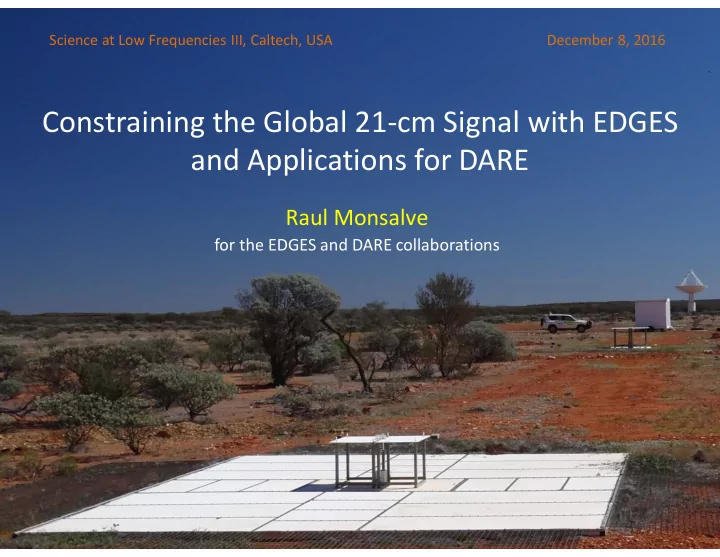

Science at Low Frequencies III, Caltech, USA December 8, 2016 Constraining the Global 21-cm Signal with EDGES and Applications for DARE Raul Monsalve for the EDGES and DARE collaborations
EDGES E xperiment to D etect the G lobal E oR S ignature Prof. Judd Bowman (PI) Dr. Alan Rogers Mr. Thomas Mozdzen Dr. Raul Monsalve
Two EDGES Instruments EDGES High Band EDGES Low Band
Location EDGES MRO
EDGES High-Band 2015-2016 Operated between: August 2015 & September 2016 Ground plane: 10m x 10m Antenna size: 1m long / 0.5m high
EDGES Low-Band 2015-2016 With OLD ground plane Operated between: October 2015 & September 2016 Ground plane: 10m x 10m Antenna size: 2m long / 1m high
NEW (Sept 2016) Low-Band Ground Plane 20m 20m 5m Welding Wiregrid Panels NEW Ground Plane: Central Square: 20m x 20m 16 Triangles: 5m-long
OLD Ground Plane NEW Ground Plane Example 10-day averages: OLD NEW 180 mK 68 mK Factor ~ 3 improvement due to NEW Ground Plane
Focusing on EDGES High-Band …..
Absorption Trough Model Cyan: Mesinger et al. (2013) Red: Fialkov et al. (2016b) Blue: Mirocha et al. (2016) Absorption Trough in some current models falls within EDGES High-Band range Gaussian Phenomenological Model � � ��� � � ��� � �� � � � = � �� · � � � : Gaussian center ∆� : Gaussian FWHM
Sample of Gaussian Models
Foreground Models � /01 (#) = “Baseline” Model + 21-cm Model Foregrounds + Ionosphere + Calibration Residuals 9 EDGES Polynomial = # ��.% 7 & 8 # 8 8:' Physical model = # ��.% & ' +& � (*+,#) + & � (*+,#) � +& . # ��.' + & � # '.%
Measurements: Spectrum and Residuals About 100 hours of Low-Foreground observations Monsalve et al., in preparation
Measurements: Preliminary Rejections < �� ≥ −150mK + 2 · D �� ; Monsalve et al., in preparation
Measurements: Preliminary Rejections E FG = −FHI JK E FG = −HI JK Monsalve et al., in preparation
Rejection Examples Preliminarily Rejected Preliminarily NOT Rejected
Physical Models: Fialkov, Cohen, et al. Fialkov et al. (2016) Cohen et al. (2016) Monsalve et al., in preparation
Physical Models: Mirocha et al. Cold EoR scenarios: • Strong Lyman alpha coupling. • No X-ray heating. • Optical depth consistent with Planck. • Ionization completed by z = 6. Discussed in Mirocha et al. (2013) Monsalve et al., in preparation
Main Characteristics • DARE probes z=11-35, or ν=40-120 MHz. Two Year Mission Lifetime. • 800 hrs integration above lunar farside shielded from Sun. • 1.6 m 50 x 125 km circular, equatorial orbit. • Instrument: biconical dipole antenna, pilot-tone injection receiver, digital spectrometer, • polarimeter. Calibration based on EDGES as a ground-based precursor. • DARE will be submitted as a mission proposal to NASA’s MIDEX program by December 15, 2016. •
On-orbit Beam Measurements • Circularly polarized, PSK modulated carriers are sent from the ground to DARE. • DARE receives signals as the spacecraft orbits above near side of the Moon to sweep beam. • Carrier levels are measured by DARE every 20 seconds to produce sampled beam cut. • A weak signal is also measured on its return trip to the Earth (Moon reflection) to estimate real-time path loss through the ionosphere. Green Bank Observatory 140-ft antenna
DARE Observatory • MCMC inference pipeline (same as LIGO, CMB). • SVD modeling of measurement uncertainties, and 21-cm models. Liu et al. (2013), Vedantham et al. (2014), Switzer & Liu (2014).
Summary • Quality of data from EDGES Low-Band has increased significantly due to improved, 25m x 25m ground plane. Measurements ongoing. • Data from EDGES High-Band enable to rule out wide range of Gaussian-like absorption troughs. For amplitude of -150 mK, preliminarily rejected widths LMN ∆O < Q . • A wide variety of physical models can also be rejected , in particular of Cold EoR scenarios. • The high-heritage, precision cosmology DARE space mission is being proposed to NASA’s MIDEX program in December 2016.
Recommend
More recommend